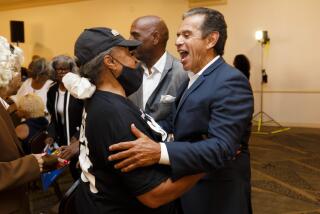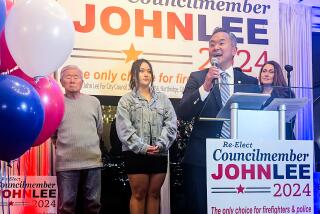A Kinder, Quicker Race for Mayor
- Share via
It’s time for the quadrennial misery known as the Los Angeles mayoral runoff. This year’s election between incumbent James K. Hahn and challenger Antonio Villaraigosa is even more dreary than usual because it’s a replay of the 2001 runoff, right down to the descent into the mud pit. Hahn tries to link Villaraigosa with drug dealers and gangs. Villaraigosa blasts Hahn over contracting and ethics scandals. Instead of hearing what’s best for the city, we are hearing what’s worst about the future mayor of L.A.
This is a turnoff for voters, and turnout is expected to be low, as it was in the 2001 and 1997 runoffs, when eligible-voter turnout averaged about 26%.
For the record:
12:00 a.m. May 9, 2005 For The Record
Los Angeles Times Monday May 09, 2005 Home Edition California Part B Page 11 Editorial Pages Desk 2 inches; 76 words Type of Material: Correction
Instant runoff -- An April 26 commentary on instant runoff election systems said that in 2002 the Los Angeles City Council voted for a feasibility study of such a system, saying “instant runoffs would save millions of dollars ... and might increase turnout by consolidating two separate votes into one.” The motion that included that language was not adopted; a motion that asked the city clerk to report on San Francisco’s instant runoff election was adopted.
Is there an alternative? Yes -- there are three options. The first is to eliminate the runoff. The highest vote-getter would win in the March election. The problem is that the mayor could be elected with far less than 50% of the vote. This year, with four major candidates, Villaraigosa would have won with barely a third of the vote. That’s undemocratic.
The second option would be to do what the French do: Shorten the runoff period to two weeks. The winner would be elected by a popular majority but taxpayers -- and candidates -- would still have to pay for a second election. As important, we’d still have a winner-take-all race giving the two finalists an incentive to pull votes from each other by going negative -- just for a shorter period.
The best option is the third one, the San Francisco option: an instant runoff, which elects a majority winner from among a large field in a single election. Here’s how it works.
On your ballot, you rank candidates in order of preference: No. 1 for your favorite candidate, No. 2 for next-favorite and so on. If no candidate wins 50% of the votes when first choices are counted, the candidate with the least number of No. 1 rankings is eliminated. If you are among the voters whose first choice is eliminated, then your No. 2 vote is tallied instead, against the remaining contenders. This is the person you’d presumably support if forced to return to the polls for a runoff. This process of dropping the last-place candidates continues until two contenders remain, and the person with a majority wins.
In last November’s election, San Francisco used instant-runoff voting for local races. Exit polls showed that voters, including the city’s non-English-speaking minorities, liked the system and found it easy to use.
San Francisco’s experience shows that instant runoffs also discourage negative campaigns. Because winners may need to attract second or third rankings from the supporters of rival candidates, all candidates must be careful about what they say about each other. That creates an incentive to find common ground and build coalitions with other candidates, rather than tearing them down.
In the March mayoral election, Hahn, Villaraigosa, Bob Hertzberg and Bernard C. Parks were all fighting for votes. In an instant-runoff scenario, they would have been courting each other’s supporters instead of attacking each other. Even the front-runners would have laid off the worst attacks for fear of a backlash.
This feature of instant-runoff voting makes it the best choice. In fact, in 2002 the Los Angeles City Council voted for a feasibility study, saying “instant runoffs would save millions of dollars ... and might increase turnout by consolidating two separate votes into one.”
Perhaps now is a good time to go beyond that resolution and enact a better runoff method.
More to Read
Sign up for Essential California
The most important California stories and recommendations in your inbox every morning.
You may occasionally receive promotional content from the Los Angeles Times.













